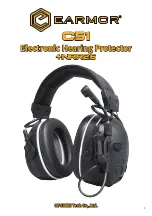
6
2.4 Drop Application
a) Load a non-absorbent specimen or a carrier strip on top of the
specimen stage (Section 2.2). Make sure the specimen is firmly
held under the four clamping fingers.
b) Apply a gentle pressure on top of the applicator knob with your
first finger and rotate the volume wheel slightly counter
clockwise between your thumb and long finger to pump out a
small pendant droplet at the dispensing tip (Figure 2.3). A
reflecting image of the droplet may now appear below the
droplet (Figure 2.4).
c) After a droplet has been pumped out at the dispensing tip, the
drop dispenser can be pushed downwards until the droplet
makes contact with the specimen surface. Upon contact, two
different situations may occur, which can be described as
a “released” droplet, (Figure 2.5)
which is immediately transferred to the specimen upon
contact with the surface;
a “trapped” droplet, (Figure 2.6)
which is in contact with the specimen surface but has not
released from the dispensing tip. In this case, slowly release
the pressure on the dispenser and the droplet should release
from the dispensing tip. If not, try using a smaller droplet
size in a new test position.
2.5 The Displayed Image
A magnified image of the released droplet should now appear on the projection screen. It is
necessary the contact point between the droplet and the substrate is in view. The image is
viewed slightly from above which produces a “reflected image” of the contacting point for a
reading.
Fig. 2.3 Drop Application
Fig. 2.5 Released droplet
Fig. 2.4 Reflecting Image
Fig. 2.6 Trapped droplet



































